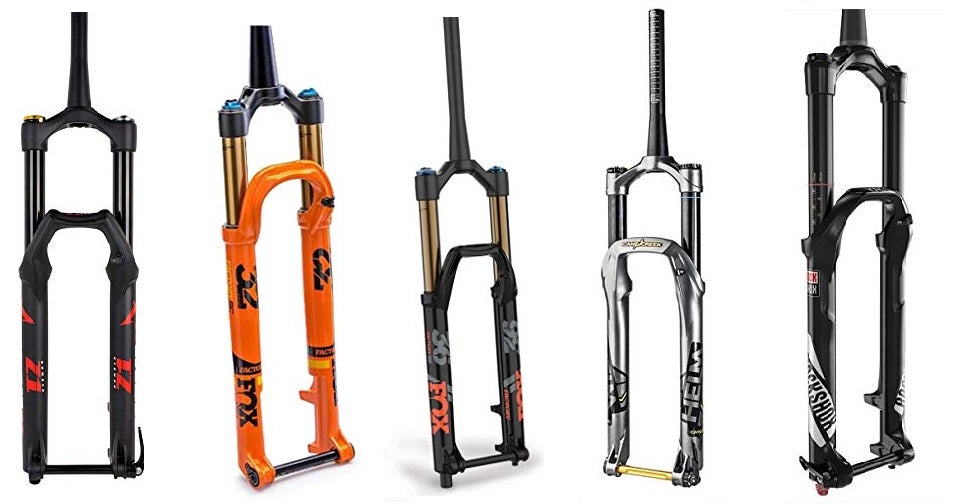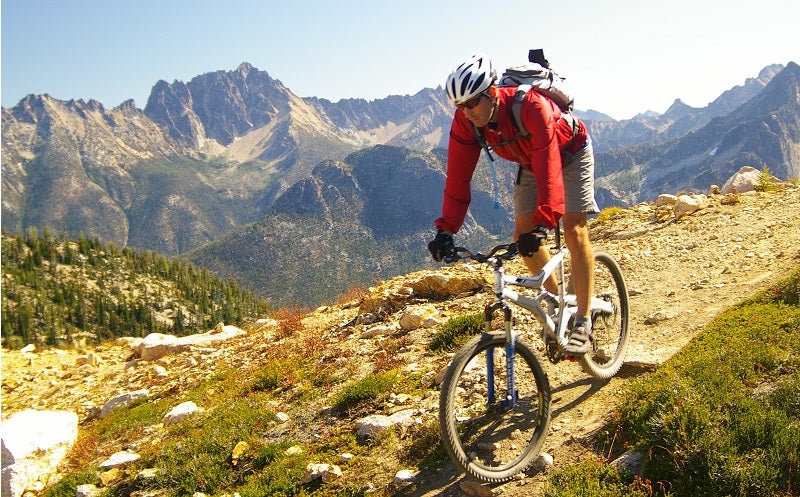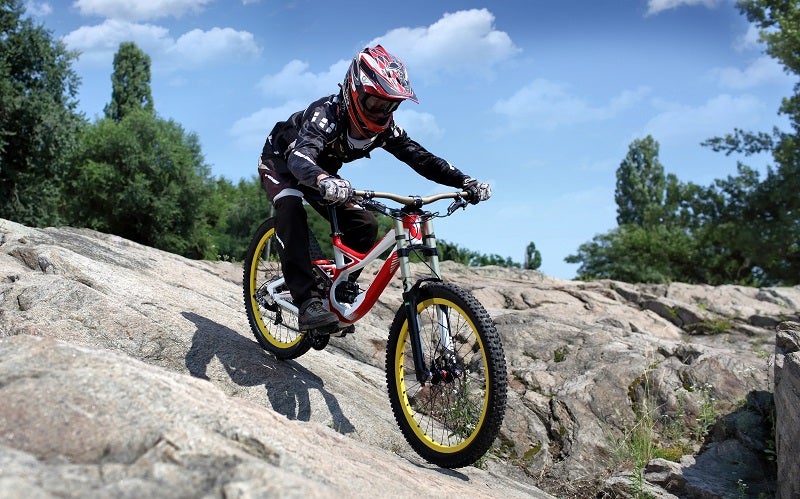
Our Editors independently research, test, and rate what we feel are the best products. We use affiliate links and may receive a small commission on purchases.
When mountain biking was a young sport, the bikes resembled road bikes with wider tires. There was no option but to use a rigid fork.
Eventually, the suspension fork for mountain bikes was invented and this changed how people could ride.
Riding a bike with a suspension fork is a smoother ride with more traction, allowing the rider to go faster and enjoy more comfort.
Before you can make a decision about the right suspension fork for you, it is important to understand what to look out for so that you can make an informed decision.
Best Mountain Bike Forks
| Fox Racing Shox 32 Float SC 29 FIT4 | RockShox Unisex's 30 Silver Tk Coil | Cane Creek Helm MKII Fork | |
|---|---|---|---|
| Travel: | 100-120mm | 80mm-120mm | 100-160mm |
| Wheel Size: | 27.5, 29” | 29", 27.5" | 27.5, 29” |
| Spring: | Air | Coil, Solo Air | Air |
| Adjustment: | Compression, Rebound | Compression, Rebound | Travel, Compression, Rebound |
For more of my MTB biking recommendations, have a look through these popular Outside Pursuits guide links: MTB Dropper Posts, MTB Helmets, MTB Rear Shocks.
Quick Answer: The 5 Best Mountain Bike Suspension Forks
- Fox Racing Shox 32 Float SC 29 FIT4
- RockShox Unisex’s 30 Silver Tk Coil
- Cane Creek Helm MKII Suspension Fork
- Fox Racing Shox 36 Float 29 Grip
- Marzocchi Bomber Z1 Coil Fork
Our reviews of the top rated MTB forks with our comparison table and buyers guide will help you choose the right one for you.
MTB Fork Reviews
#1 Fox Racing Shox 32 Float SC 29 FIT4
- Travel: 100-120mm
- Wheel Size: 27.5, 29”
- Spring: Air
- Adjustment: Compression, Rebound
This is the best and lightest XC fork on the market. It just got lighter and stiffer thanks to the step cast dropout and new crown design.
Fox claim this makes the 32 just as stiff as its trail-oriented bigger brother, the 34. What has not changed is the exceptional damping on offer.
The Fit4 damper is seriously impressive, managing to always be smooth and controlled. At the start of the travel, it is supple and it irons out small bumps and trail chatter fantastically.
It is supportive in the mid-stroke and big impacts are soaked up without the fork bottoming out.
This not only means a comfortable and efficient ride, but also ultimate traction and speed. Just what you need from a XC fork.
Volume spacers are included so you can tune the air spring to your weight.
Low-speed compression and rebound can be externally adjusted and there is a dial to switch the compression between three modes.
You can change between open, medium, or firm depending on the trail conditions. There is even a handlebar-mounted remote switch available for serious racers.
#2 RockShox Unisex’s 30 Silver Tk Coil
- Travel: 80mm-120mm
- Wheel Size: 27.5, 29”
- Spring: Coil, Solo Air
- Adjustment: Compression, Rebound
The Silver Tk is a great-performing affordable fork for those who do not want or need endless tuning options.
With dials only for rebound and low-speed compression, after you have set the correct sag, there is not much tuning that can be done.
This is a fork for anyone that does not need pro-levels of tuning because they just want to enjoy the ride. That is not to say that the Silver Tk is for easy trails. Far from it.
Stiff 35mm magnesium lower legs keep the front wheel pointing where you want it to go.
The Motion Control damper is ready to soak up big impacts while the Rapid Recovery helps it to quickly return after the big hits.
Blasting through chunky rock gardens can be a bit much for the damper and you may at times need to rely on your arm strength to get through.
If this is likely to be a problem for you, it is possible to upgrade to the Charger damper.
Regardless of which damper you use, it is advisable (for average weight riders) to install two volume tokens, as the large negative air chamber tends to allow the fork to easily push through its travel.
If you want to tackle some big trails with an affordable fork, the Silver Tk is perfect for you.
#3 Cane Creek Helm MKII Suspension Fork
- Travel: 130-160mm
- Wheel Size: 27.5, 29”
- Spring: Air
- Adjustment: Travel, Compression, Rebound
This is a beast of a fork that can be used for a variety of riding styles. The travel is adjustable between 130mm and 160mm, allowing you to use it for XC, trail riding, enduro, or bike park riding.
It is most at home on big, aggressive trails that demand a long travel fork.
The stiff 35mm stanchions paired with the impressive damping system allow you to push this fork harder and harder into rough trail sections.
It is not just the travel that is adjustable, but also high- and low-speed compression, as well as low-speed rebound.
On top of this, the air pressure in both the positive and negative air chambers can be independently set and the air volume can be changed without the use of volume reducers.
This means that you will need to dedicate some time to get the Helm set up correctly for your weight and riding style. Most riders do not need this many options.
For those that do want it and have the necessary technical understanding, the rewards are huge.
#4 Fox Racing Shox 36 Float 29 Grip
- Travel: 150-160mm
- Wheel Size: 29”
- Spring: Air
- Adjustment: Compression, Rebound
The Fox 36 is a tried and tested enduro fork that is perfect for racers. It has proved itself many times by appearing on the top step of podiums at the highest level of the sport.
This is in part due to the new GRIP 2 damper that offers more adjustment and more supple movement than the older Fit RC2 damper.
By using the same oil in the lower legs as the dampers, the damper seals can be looser, resulting in less friction.
Any extra oil that ends up in the damper gets pushed back into the lowers.
Enduro racers need to fine-tune their fork to the conditions of each race. The 36 allows you to adjust high- and low-speed rebound as well as high- and low-speed compression.
Most forks do not offer adjustable high-speed rebound and it can be tricky to get everything right.
For beginners, recommended settings are printed on the leg to give you a starting point. Volume spacers can be added to tune the progression.
Performance on the trail is top-notch. Small bumps and big impacts are soaked up with no fuss.
The 36 never feels harsh on big impacts, despite using less travel than you would expect.
It is also very supportive in the mid-stroke, allowing you to blast around corners at speed without the fork diving through its travel.
#5 Marzocchi Bomber Z1 Coil Fork
- Travel: 130-180mm
- Wheel Size: 27.5, 29”
- Spring: Air
- Adjustment: Compression, Rebound
Heavy but with good performance at an affordable price is how the Bomber Z1 can be summed up.
Marzocchi is owned by Fox and this fork benefits from the same GRIP damper as the Fox 36. However, the air volume is smaller and less adjustment is available.
One dial simultaneously adjusts the high- and low-speed compression, allowing you to define a range rather than fine-tune each one.
Traction is good but suppleness is worse than higher-priced forks. Although small bumps are not absorbed as well, the Z1 does deal very well with medium and large impacts.
The beginning stroke is quite firm and it is recommended to add one more volume spacer to the two that are already installed.
This will unlock some suppleness at the start of the travel and prevent bottoming out. Even with three spacers installed, the mid-stroke support can be a bit lacking.
Regardless, the Z1 does do a great job and is an excellent choice if you do not have too much to spend.
Mountain Bike Forks Comparison Table
| MTB Forks | Travel | Wheel Size | Spring | Adjustment | Rating | |
|---|---|---|---|---|---|---|
| Fox Float 32 | 100-120mm | 27.5, 29” | Air | Compression, Rebound | 4.7 / 5.0 | |
| RockShox Unisex's 30 Silver Tk | 80mm-120mm | 27.5, 29” | Coil, Solo Air | Compression, Rebound | 4.8 / 5.0 | |
| Cane Creek Helm Air | 130-160mm | 27.5, 29” | Air | Travel, Compression, Rebound | 4.4 / 5.0 | |
| Fox Factory 36 Float | 150-160mm | 29” | Air | Compression, Rebound | 5.0 / 5.0 | |
| Marzocchi Bomber Z1 | 130-180mm | 27.5, 29” | Air | Compression, Rebound | 4.3 / 5.0 |
How to Choose the Best MTB Suspension Fork – Buyers Guide

The first suspension forks on the market were premium products. Thankfully we have come a long way since then. Pretty much every modern mountain bike now comes with a suspension fork.
Although budget forks can perform well, you might be interested in upgrading if you want a fork with more settings or better performance. Let’s now get into suspension fork considerations.
Travel
The length of stanchion that slides into the legs of the fork is called travel. It is measured in mm. Mountain bike suspension forks have between 80mm and 200mm of travel.
The amount of travel you need for your bike depends mainly on your frame. Each frame is usually designed around a specific length fork, but sometimes a range.
It is important to check this before making a purchase.
Although it is possible to install a longer than intended fork onto a frame, this will upset the frame geometry, potentially making the bike behave strangely on the trail and be uncomfortable to pedal.
Some frames can take different length forks. In this case, it is up to you to decide if you need more or less travel. Longer travel forks can soak up bigger impacts from trail obstacles, as well as landings from jumps and drops.
On the other hand, a shorter travel fork is lighter and you might not need so much travel depending on the kind of riding you do.
Recommend Travel For Riding Types:
- Cross-country Riding: 100-120mm
- Trail Riding: 120-150mm
- Enduro Riding: 150-180mm
- Downhill Riding: 180-200mm
Air or Coil Spring
After being compressed, suspension forks return to their original position. This is achieved either from air inside the fork, or a metal coil.
The latter is generally associated with badly performing budget forks, but recently some excellent forks with coil springs have come on to the market. The difference between the two systems is how the fork reacts to big and small impacts.
When a fork reacts to an impact, the air inside an air fork is compressed. As air is compressed, the harder it is to compress it further.
As a result, it is easy to move an air fork at the start of its travel whereas more and more force is required to move it as it gets deeper into its travel. This is called progression.
Coil springs are not progressive and move in what is called a linear way. For this reason, it is important to use the correct spring weight to avoid harsh bottom outs.
The advantage of coil springs is that they are a lot more sensitive to small bumps which gives a smoother ride and better traction
Whether you need a coil or air shock comes down to your preferences and style of riding.
XC bikes always have air shocks because they are lighter.
Downhill bikes have coil shocks for the superior traction.
Enduro riders often choose a coil shock but there are plenty of enduro bikes with air shocks.
For the average trail rider, have a think about the trails you ride and what kind of shock would be best.
If you tend to ride smoother flowing trails then an air shock is best whereas a coil shock is better suited to trails with rough, technical descents.
Adjustment Options
A suspension fork is likely to have various dials and setup options to tune its behavior to your weight and riding style. Air forks have an air valve for you to set the correct air pressure.
Coil forks have a preload dial to adjust the spring stiffness. On top of that, you are likely to find dials for compression damping and rebound damping.
Low-speed compression controls how fast the fork moves in reaction to small bumps whereas high-speed compression is for big, fast impacts.
Rebound damping is about how fast the fork is allowed to return after being compressed and settings can be found for both low- and high-speed rebound.
Most forks allow you to adjust just the low-speed compression and have one dial for both high- and low-speed rebound, which is enough for most people. Some premium forks have dials for all of them.
The behavior of air forks can be further tuned by adding volume reducers (also called tokens or spacers). These are fitted inside one of the stanchions.
By reducing the air volume inside the fork, it will become harder to compress at the end of the travel and plusher at the start. Coil forks can be tuned by installing a different weight spring.
Many forks also have a dial to lock out the fork for climbing and open it for trail riding or descents. These dials commonly have two or three positions.

Wheel Size
Mountain bikes come with 26, 27.5, or 29” wheels. It goes without saying that you cannot fit a 29” wheel into a fork made for 26” wheels.
Although it could be possible the other way around, you are best off sticking to a fork that is intended for your wheel size.
Hub Width
Wheel hubs come in various widths. There are often adapters available to fit a hub into a wider fork, but obviously you cannot force a wider hub into a narrower fork.
Check what size hubs you have and if adapters exist before making a purchase.
Dropout Type
Dropouts are where each side of the hub fits into the fork. Everything is held in place with either a quick-release skewer or a wider through axle.
The compatibility of your hub with your new fork is something that you will also have to check.
Steerer Tube
This is the part of the fork that goes through the frame called the head tube and attaches to the stem and handlebar.
Modern mountain bike frames have a tapered head tube that is wider at the bottom. Older frames have a non-tapered head tube.
Forks with tapered steerer tubes cannot be fitted to a frame with a non-tapered head tube. Nearly every suspension fork and frame produced these days has a tapered steerer tube.
How We Researched
To come up with the top mountain biking helmets, we researched a variety of sources for reviews such as Competitivecyclist, JensenUSA, REI, EVO along with our own personal experience.
We also consulted online magazines for product research and reviews to get as much unbiased information as we could. To help weed out fake reviews we used Fakespot.com to make sure we only looked at genuine reviews.
With so much quality gear available, we had to narrow it down based on what we felt were the best options were for the price. The author, Richard Bailey has a wide background in mountain biking in a variety of countries, terrain types and bike packing for weeks on end.
The author has decades of experience and is eager to share his knowledge with readers.
To help narrow down the selection we used personal experiences along with recommendations from fellow MTB bikers, bloggers and bike shops.
After extensive research, we came up with our list to help you choose the right one for you.
